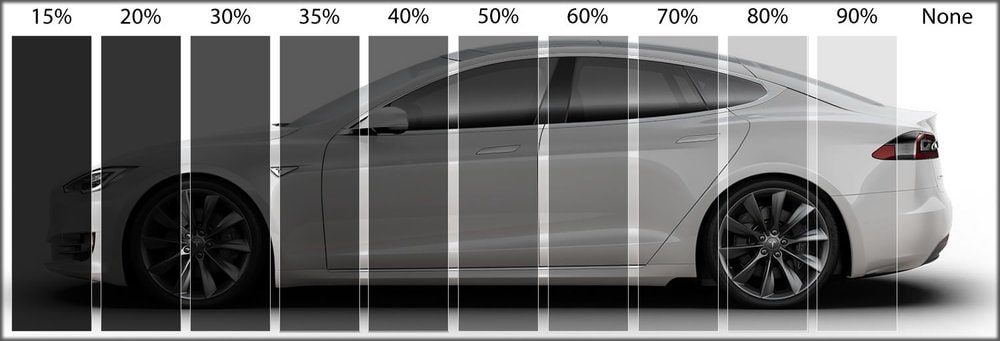WINDOW TINTING
The process of applying laminated tint on the vehicle's glass in order to make it darker as a protective or cosmetic purpose. The main purpose of this process is to reduce the amount of heat and radiation from the sun that reaches the interior of the vehicle, The thickness of the film and the material from which it is made can vary. There is a law that prevent vehicle's windows to be too dark, our car detailing specialist are well aware of the laws in Ontario. We back our work with different term of warranties.
WHAT IS CAR WINDOW TINTING?
As we said earlier it's a thin laminate film that can be installed to the interior or exterior of glass surfaces in automobiles and boats and also to the interior or exterior of glass in homes and buildings. It is usually made from polyethylene terephthalate (PET), a thermoplastic polymer resin of the polyester family, due to its clarity, tensile strength, dimensional stability, and ability to accept a variety of surface-applied or embedded treatments.


WHAT ARE THE DIFFERENT TYPES OF CAR WINDOW TINT?
Dyed :
Generally used for appearance instead of functionality. When you want the darkest look for your vehicle, this is the best option. It has a layer of dye between the adhesive layer and a protective top coating made of polyester. The adhesive side sticks to the glass while the top coat protects your window from accidental scratches. Unfortunately, the dye fades over time from excessive UV exposure, turning the film from black to purple. You can slow down the fading process by storing your vehicle in a garage or away from constant sun exposure. Although most people use it for appearance purposes, it's also the most economical and least expensive option compared to the other four. Because they are known for being the darkest option, you may worry about being able to see through your side or rear windows. You'll be happy to learn that the film still provides an appropriate amount of visibility so you can see cars approaching from the rear or objects on the side if you’re parallel parking.Carbon :
It offers you a dark, matte finish with a sleek vibe. Hundreds of polymer and carbon microlayers block infrared light from penetrating the car's interior. If you have leather seats or other distressed upholstery, carbon tints can help mitigate the adverse effects of UV light. It covers the upholstery and keeps it from fading without large quantities of infrared touching the interior of your vehicle. Carbon layers keep the inside cold as well. During the season, you won't have to focus on your air conditioning at full blast or put your machine in high heat for the winter months. With no metal integrated into the layers, the film won’t interfere with your technology or other parts of your vehicle. It doesn't fade over time, unlike dyed films, making them more durable and longer lasting.Ceramic :
It is the highest quality compared to the other four. However, it is also the most expensive. Instead of dye, metal or carbon, it contains ceramic particles that are non conductive and nonmetallic. The elements reflect and reduce solar heat and UV rays from entering the car. While it reflects and absorbs high levels of light, it also allows for maximum visibility. It resist glare and fading and are highly shatter-proof.
Hybrid:
The composite film is a blend of dyed and metalized, taking the positives of both and getting rid of the drawbacks. An adhesive layer which adheres to the glass is the initial piece. Next, along with a protective top coat to avoid scrapes, a dyed and metalized coating is integrated into the film. With the use of a laminating glue, each film binds together. The hybrid film can block a reasonable amount of light because of the dyed coating, while its metallic sections produce a crisp, dark look. A widespread misconception is that the darker the film is, the more heat is rejected by it. When it comes to hybrid films, that is not the case. They block heat well, but relative to a single piece of colored tint, they remain lighter in color. Again, without any negatives, hybrid film maintains all the advantageous properties of dyed and metalized.Metalized :
Metallic particles are trapped in the material, making it a thicker form of film. The film also has a treated coating to block UV radiation, made by an adhesive base layer that attaches to your car window, and a metalized layer that absorbs heat and darkens the glass. A final top coat acts as a protective layer to prevent scratches and nicks. Built with many layers, reflect heat from the light, holding it outside the vehicle to shield the inside. Not only can the metal components inside the layers reinforce the glass, making it more sturdy and shatter-resistant, but they also give the exterior a glossy look. The reflective properties can not be the look you desire, since a matte finish is possible . The metallic properties also conflict with electronics such as your GPS, mobile phone and radio reception, even though the film has some good qualities. It may cut in and out your phone signal, and your GPS device may be unusable by accident. It does not influence you as often as someone who has mobile equipment set up if you don't use electronics regularly when traveling.WHAT ARE THE BENEFITS OF CAR WINDOW TINTING ?
APPEARANCE
It gives a clean, “finished” look while cutting down on glare from sunlight. It makes the car look more sleek .Comfort
creates a more comfortable environment, whether it is installed on a vehicle or a home or commercial building. It can make a car up to 60% cooler in the summertime, cutting down on your car being extremely hot when you enter it.UV Protection
It blocks 99% of the sun’s ultraviolet rays from entering your home, business, or vehicle. This helps reduce glare while protecting skin and eyes from damage. By blocking UV rays, window tinting also helps protect furnishings, upholstery, paintings, and tapestries from fading and discoloration.Privacy
Window films afford a clear view to the outside. Depending on the privacy desired, you can increase privacy by selecting films that prevent others from looking in during the daytime.






